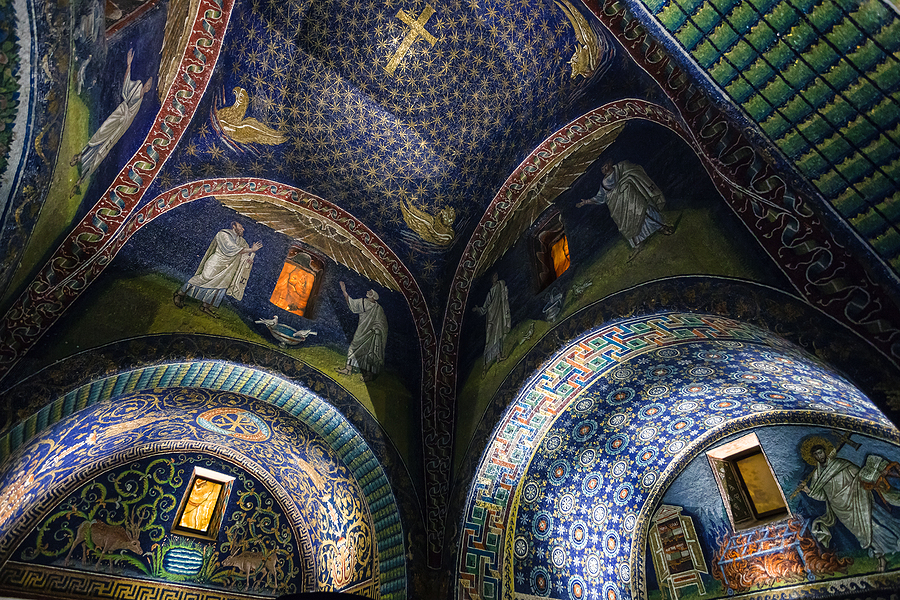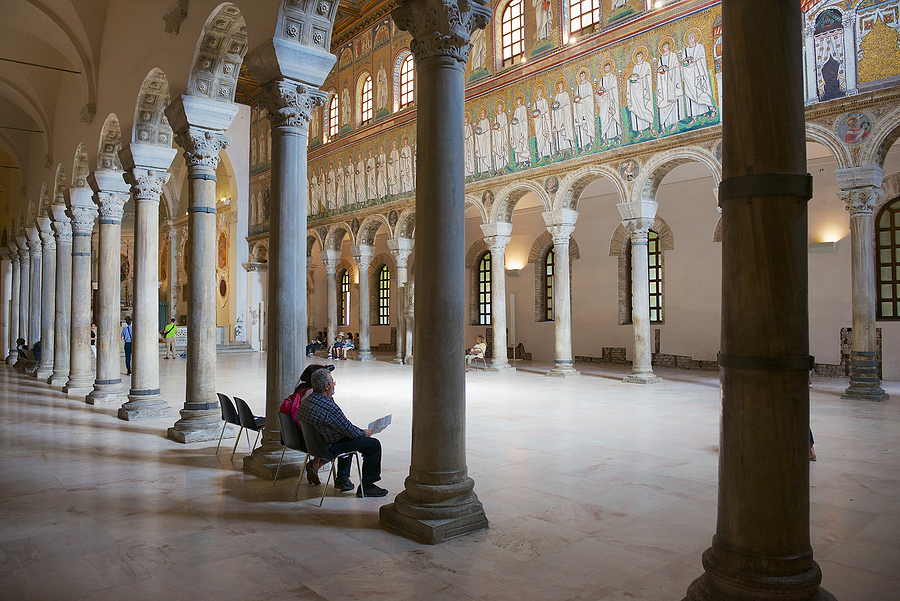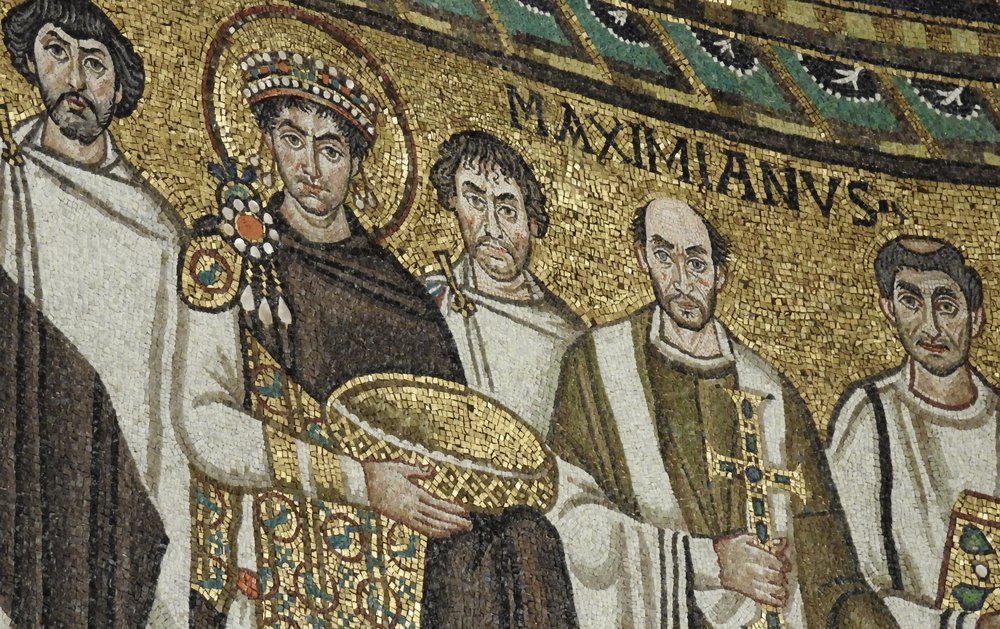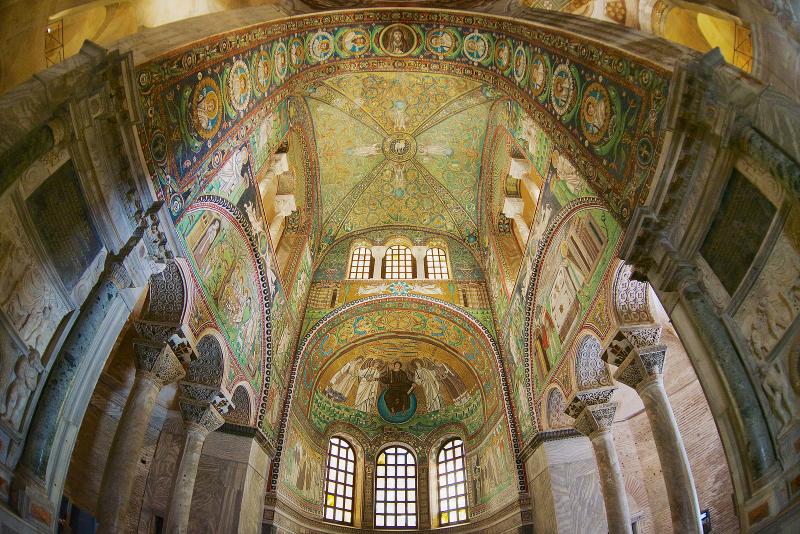Today, the town of Ravenna is one of Emilia-Romagna’s most important economic and industrial centers. Its thriving port serves the chemical, gas, and shipping industries. The nearby coastline attracts visitors looking for a slower pace and quiet escape under a beach umbrella. And the town of Ravenna itself is a great place to explore by bike. But first things first: Visiting Ravenna’s impressive ancient monuments means experiencing the splendor of a bygone age unique on the Italian peninsula.
Fifteen hundred years ago, Ravenna became the center of a thriving culture not seen before or since. This small city on Italy’s Adriatic coast formed the capital for three distinct ancient cultures. As these ancient powers rose and fell, Ravenna also became Italy’s most significant capital of mosaic art.
What’s unique about Ravenna is the astounding number of impressive buildings from this early period of the fifth through the seventh centuries AD, as well as their state of preservation. Ravenna is a beautiful study in the transition from the classical to the medieval world. For these reasons, it’s no wonder that UNESCO has designated no less than eight World Heritage Sites in Ravenna alone.

Ravenna: the link between antiquity and the medieval world
Studying Ravenna’s history means a deep dive into murky waters. What’s important to remember is that after the decline of the Roman empire, the Italian peninsula fell into a complex period characterized by several centuries of upheaval and ever-shifting political powers. During this unstable time, Ravenna emerged as an important strategic location because of its defensible marshlands and its port, as well as its easy access to more powerful cities east of the Italian peninsula.

Late Roman era (late 300s – 480s AD): During the late Roman era, Ravenna was an imperial port housing a large naval fleet. As things in Rome itself began to fall apart in the fourth century, Ravenna briefly became the capital of the Roman empire as cultural and political power began to shift eastward to Constantinople and other centers in the eastern Mediterranean.
Ostrogothic era (480s – 540 AD): As various barbarian tribes battled over every corner of the Roman empire, Ravenna became the capital for the Ostrogothic king Theodoric.
Byzantine era (540 – 600 AD): In 540 AD, the Byzantine emperor, Justinian, made Ravenna the westernmost capital of the Byzantine Empire. Ravenna’s reliance on trading and political contacts east of the Italian peninsula helps us understand how a more eastern aesthetic characterized Ravenna’s art and architecture.
Ultimately, in 751 AD, the Lombards forced the Byzantines out of Ravenna and the town once again slipped into relative obscurity. Luckily for us, a great number of impressive monuments from Ravenna’s glory days remain for us to enjoy.
What to see in Ravenna
While Ravenna can be organized as a day trip from Bologna, Venice, or Padua, it’s better to spend a night or two if you want to experience the splendor of its ancient monuments most fully. Here’s what not to miss:
The Late Roman Era
One of the cool things about studying Ravenna’s Roman period is that it gives us a chance to become acquainted with one of ancient history’s most fascinating women, Galla Placidia (392-450 AD). Daughter of Emperor Theodosius I, Galla became a major force in Roman politics. While the city of Rome fell into chaos and Romans moved inside the walls of the Colosseum for protection from barbarian invasions, Ravenna—situated in a more easily defendable, marshy hinterland--became an unlikely oasis of Roman culture. There, Galla Placidia became an important patron of churches:
Basilica of San Giovanni Evangelista
. Early 5th century AD
Via Giosue Carducci, 48121 Ravenna
0544/541688
An inscription tells us that Galla Placidia had this church built in gratitude after she and her two young children survived a near-shipwreck on a sea voyage from Constantinople to Ravenna. Like all the ancient monuments in Ravenna, this church has been expanded and redecorated over many centuries. In the late Middle Ages, the Benedictines amplified it with an important monastery. Allied forces accidentally bombed this church during World War II, so it’s been largely rebuilt. A series of narrative mosaics once told the story of the dramatic sea rescue and bolstered the family’s political dominance. The original decoration is mostly lost but its subject matter survives in written descriptions. Still, the church is worth a visit to understand the form and function of an early Christian basilica.
Mausoleum / Oratory of Galla Placidia
Early 5th century AD
Via San Vitale, 48121 Ravenna
0544/541688
In spite of the fact that this building carries a reputation as a mausoleum, Galla Placidia was most likely buried in Rome. More likely, this cross-shaped building formed a private chapel or oratory, and was originally attached to the narthex of a much larger church (now destroyed) called Santa Croce. The Oratory of Galla Placidia is a rare example of a late antique building that retains its complete original decorative mosaic program. The imagery is typical of early Christian themes: Jesus as the Good Shepherd, the lion of Mark, the eagle of John, a great golden cross above it all. These mosaics are some of the most spectacular in Ravenna; don’t miss them!

Orthodox or Neonian Baptistery
Early 5th century AD
Piazza Duomo 1, 48121 Ravenna
0544/541688
Baptism was a relatively new idea for early Christians in the Roman empire. Like many early Christian baptisteries, the so-called Orthodox or Neonian Baptistery of Ravenna was constructed as an octagonal building with a great baptismal font at its center. It lay on the grounds of the cathedral and was decorated with bright, multicolored mosaics representing the twelve apostles in its dome. This is considered one of the finest and most complete surviving examples of an Early Christian baptistery, and is not to be missed.
The Ostragothic Era
After the emperor Valentinian III moved the imperial court back to Rome in the 440s, Ravenna became a secondary hub for Roman rulers. It wasn’t long before Theodoric, king of the Ostrogoths, made a go for Ravenna. The Ostrogoths were a tribe of people who originated in the Balkans. They consolidated their power over the course of the 400s and fought their way onto the Italian peninsula. According to historical sources, Theodoric besieged Ravenna for three years with the intent of making it his capital; in 493, he finally succeeded.
Arian Baptistery
Early 6th century
Vicolo Degli Ariani 1, 48121 Ravenna
0544/543724
The Ostrogoths were Arian Christians; Theodoric may have intended to make Ravenna’s Ostrogothic monuments a public display of Arianism. Between the fourth and the seventh centuries after the death of Christ, the nature of the Holy Trinity was one of the most hotly debated topics among early Christians. Arians followed the idea that Christ held a lower status than God the Father. In the Arian Baptistery, the dome’s mosaics are well preserved, depicting the Baptism of Christ surrounded by apostles.
Basilica of Sant’Apollinare Nuovo
Early 6th century
Via di Roma 52, 48121 Ravenna
0544/541688
This basilica was built during the reign of Theodoric as a palatine church, meaning that it was considered part of the larger complex of Theodoric’s palace. The mosaics are spectacular, preserving a full decorative program down the walls of the nave depicting over-life-sized saints and fascinating depictions of architecture.

Mausoleum of Theodoric
Early 6th century
Via delle Industrie 14, 48122 Ravenna
0544/543724
The extraordinary Mausoleum of Theodoric is the only surviving tomb of a barbarian ruler. This singular building is constructed of large blocks of Istrian limestone, arranged in a circular construction. Its original mosaic decoration no longer survives but its architecture is extremely impressive.
The Archbishop’s Chapel
6th century
Piazza Arcivescovado, 48121 Ravenna
0544/541688
This private bishops’ chapel is rare for its spectacular, near-intact, sixth-century mosaic program. Today, the chapel is incorporated like a gemstone within the Archiepiscopal Museum. During your visit, peruse many other Ravennate treasures including ancient inscriptions, the contents of the cathedral treasury, the remains of mosaics from the ancient basilica of Ursus, and the sixth-century ivory throne of the bishop Maximian.
The Byzantine Era
After Theodoric’s death, Ravenna entered another period of uncertainty before Justinian, the Byzantine emperor, claimed the city as his westernmost capital in 540 AD. While other cities of the Italian peninsula were subsumed in the chaos of invasions, plague, and economic uncertainty, Ravenna continued to flourish under Byzantine rule through the end of the seventh century. Between 540 and 600, the Byzantines constructed some of the city’s most lavish mosaic-encrusted buildings.
Basilica of San Vitale
Early 6th century
Via San Vitale, 48121 Ravenna
0544/541688
One of the most impressive monuments of Ravenna (and that’s saying something!), the church of San Vitale combines the best of eastern and western early Christian architectural traditions. In addition, its mosaics—intended to portray peace and order thanks to God and Byzantine rule—are among the most famous in the history of art. Justinian, his empress Theodora, and their imperial retinue stare down at us from the walls among vast spaces of twinkling, sparkling gold. No pictures can do the experience justice.

Sant’Apollinare in Classe
Mid-6th century
Via Romea Sud 224, 48124 Classe
051/4209406
Located five kilometers south of Ravenna’s city center, the town of Classe was an extension of the city and once contained many earlier Christian monuments. Today, the Basilica of Sant’Apollinare in Classe bears testament to the richness of the sixth-century building tradition in this area. Beautiful early Christian mosaics survive in the apse.
More explorations in and around Ravenna
Mosaic Museum
Museo TAMO—Tutta l’Avventura del Mosaico
Complesso di San Nicolò, Via Rondinelli 2, 48121 Ravenna
0544/213371
This small museum recounts the history of mosaic art in Ravenna, with an informative exhibition demonstrating the painstaking process of mosaic restoration.
Mosaic Art School "Luciana Notturni"
Via Francesco Negri 14, 48121 Ravenna
0544/67061
Try your hand at creating mosaics of your own! This fun mosaic school offers multi-day workshops and something for all levels.
Dante’s Tomb
Via Dante Alighieri, 9, 48121 Ravenna
0544/215676
The story of how Dante Alighieri—a Florentine—came to be interred in Ravenna is one of the most fascinating case studies of social psychology I’ve ever read. Learn more about it here and while you’re in Ravenna, stop by Dante’s tomb to pay your respects to this giant of Italian literature and culture.

Marina di Ravenna
Once you’ve explored the rich historical treasures of the city, it’s time to relax at the beach. Marina di Ravenna is a sleepy beach town northeast of Ravenna. The Adriatic coast attracts fewer tourists than many Italian coastal resort towns, so it’s a great place to relax with an umbrella and gelato in the sand. The hotels and restaurants are a relative bargain, so it’s a great place to stay while you’re exploring Ravenna. Things may soon change, however. With mounting pressure to rid Venice of large cruise ships, the industrial port west of Marina di Ravenna recently has become an alternate hub for cruise ships traversing the Adriatic.
Laura Morelli is an art historian and historical novelist with a passion for Italy. You can find much more about what to bring home from Italy in her guidebook series, including Made in Florence and Made in Italy. These books, along with Laura’s Venice-inspired historical novels, including The Gondola Maker, are available in the Italy Magazine shop.








